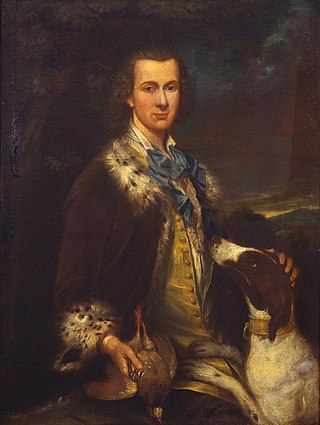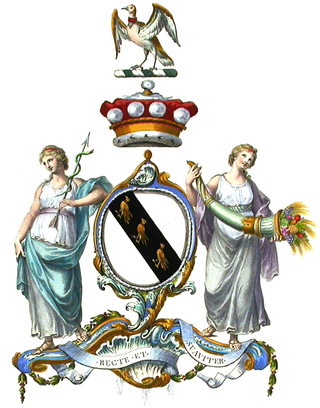Duke of Newcastle upon Tyne was a title that was created three times, once in the Peerage of England and twice in the Peerage of Great Britain. The first grant of the title was made in 1665 to William Cavendish, 1st Marquess of Newcastle upon Tyne. He was a prominent Royalist commander during the Civil War.

David Alfred Thomas, 1st Viscount Rhondda, PC, was a Welsh industrialist and Liberal politician. He was UK Member of Parliament (MP) for Merthyr Tydfil from 1888 until the January 1910 general election, then MP for Cardiff until the December 1910 general election, when he left politics to concentrate on his business interests. He was made a member of the Privy Council in 1916. He later held office, notably as "Food Controller" in Lloyd George's wartime coalition government.

Viscount Cobham is a title in the Peerage of Great Britain that was created in 1718. Owing to its special remainder, the title has passed through several families. Since 1889, it has been held by members of the Lyttelton family.

Earl of Wilton, of Wilton Castle in the County of Herefordshire, is a title in the Peerage of the United Kingdom. It was created in 1801 for Thomas Egerton, 1st Baron Grey de Wilton, along with the subsidiary title of Viscount Grey de Wilton, also in the Peerage of the United Kingdom. Both titles were created with remainder to the second and all younger sons successively of his daughter Eleanor, wife of Robert Grosvenor, 1st Marquess of Westminster.

Earl of Limerick is a title that has been created twice in the Peerage of Ireland, associated first with the Dongan family, then with the Pery family. It should not be confused with the title Viscount of the City of Limerick held by the Hamilton family also Earls of Clanbrassil.

Earl Nelson, of Trafalgar and of Merton in the County of Surrey, is a title in the Peerage of the United Kingdom. It was created on 20 November 1805 for the Rev. William Nelson, 2nd Baron Nelson, one month after the death of his younger brother Vice-Admiral Horatio Nelson, 1st Viscount Nelson, the famous naval hero of the Napoleonic Wars and victor of the Battle of Trafalgar of 21 October 1805. The title is extant, the present holder being Simon Nelson, 10th Earl Nelson, who has an heir apparent. The family seat of Trafalgar House in Wiltshire was sold in 1948 by Edward Nelson, 5th Earl Nelson.

Earl of Lonsdale is a title that has been created twice in British history, firstly in the Peerage of Great Britain in 1784, and then in the Peerage of the United Kingdom in 1807, both times for members of the Lowther family.

Earl Jellicoe is a title in the Peerage of the United Kingdom. It was created, along with the subsidiary title Viscount Brocas, of Southampton in the County of Southampton, on 29 June 1925 for Admiral of the Fleet John Jellicoe, 1st Viscount Jellicoe, on his return from being Governor-General of New Zealand, with remainder to the heirs male of his body. He had already been created Viscount Jellicoe, of Scapa in the County of Orkney, on 15 January 1918, created with remainder to the heirs male of his body, and in default of such issue to his eldest daughter and the heirs male of her body, with the like remainder in default of such issue to every other daughter successively in order of priority of birth, and to the heirs male of their bodies. The Jellicoe viscountcy was created with remainder to his daughters and their heirs male because, at the time of the creation, Jellicoe had five daughters and no sons. His only son was born three months later.

Earl Kitchener, of Khartoum and of Broome in the County of Kent, was a title in the Peerage of the United Kingdom. It was created in 1914 for the famous officer Field Marshal Herbert Kitchener, 1st Viscount Kitchener of Khartoum. He had already been created Baron Kitchener of Khartoum, and of Aspall in the County of Suffolk, in 1898, Viscount Kitchener of Khartoum, and of the Vaal River in the Transvaal Colony, and of Aspall in the County of Suffolk, in 1902, and was made Baron Denton, of Denton in the County of Kent, and Viscount Broome, of Broome in the County of Kent, at the same time he was granted the earldom. These titles were also in the Peerage of the United Kingdom.

Earl of Gainsborough is a title that has been created twice, once in the Peerage of England and once in the Peerage of the United Kingdom. The first creation ended in extinction when the sixth Earl died without heirs. However, the title was revived in 1841 for a female-line relative.

Earl Howe is a title that has been created twice in British history, for members of the Howe and Curzon-Howe family respectively. The first creation, in the Peerage of Great Britain, was in 1788 for Richard Howe, 4th Viscount Howe, but it became extinct upon his death in 1799. The second creation, in the Peerage of the United Kingdom, was in 1821 for Richard Curzon-Howe, 2nd Viscount Curzon, and it remains extant.

Viscount Massereene is a title in the Peerage of Ireland. It was created in 1660, along with the subsidiary title of Baron Loughneagh. From 1665 to 1816 the Skeffington Baronetcy of Fisherwick was attached to the viscountcy and from 1756 to 1816 the Viscounts also held the title of Earl of Massereene. Since 1843 the peerages are united with titles of Viscount Ferrard, of Oriel and Baron Oriel, both in the Peerage of Ireland, and Baron Oriel, in the Peerage of the United Kingdom. The Viscount also holds the subsidiary titles of Baron Loughneagh (1660) and Baron Oriel (1790) in the Peerage of Ireland and Baron Oriel (1821) in the Peerage of the United Kingdom. As Baron Oriel, he sat in the House of Lords until 1999.

Viscount Ridley is a title in the Peerage of the United Kingdom. It was created in 1900 for the Conservative politician Sir Matthew White Ridley, 5th Baronet, Home Secretary from 1895 to 1900. He was made Baron Wensleydale, of Blagdon and Blyth in the County of Northumberland, at the same time, also in the Peerage of the United Kingdom. The latter title was a revival of the barony held by his maternal grandfather James Parke, Baron Wensleydale, whose title became extinct upon his death since none of his sons survived him.

Viscount Bridport is a title that has been created twice, once in the Peerage of Great Britain and once in the Peerage of the United Kingdom. The first creation became extinct in 1814, while the second creation is still extant.

Viscount Scarsdale, of Scarsdale in Derbyshire, is a title in the Peerage of the United Kingdom. It was created in 1911 for the prominent Conservative politician and former Viceroy of India George Curzon, 1st Baron Curzon of Kedleston, who was created Earl Curzon of Kedleston at the same time and was later made Marquess Curzon of Kedleston.
Baron Ravensdale, of Ravensdale in the County of Derby, is a title in the Peerage of the United Kingdom.

Earl or Lord of Clanricarde is a title that has been created twice in the Peerage of Ireland, first in 1543 and again in 1800. The former creation became extinct in 1916 while the 1800 creation is extant and held by the Marquess of Sligo since 1916.

Baron Keith was a title that was created three times in British history, with all three creations in favour of the same person, Admiral the Honourable Sir George Keith Elphinstone. He was the fifth son of Charles Elphinstone, 10th Lord Elphinstone by his wife Lady Clementine, daughter of John Fleming, 6th Earl of Wigtown and Lady Mary, daughter of William Keith, 8th Earl Marischal. The first creation came in the Peerage of Ireland in 1797 when he was made Baron Keith, of Stonehaven Marrischal, with remainder in default of issue male of his own to his daughter and only child from his first marriage, Margaret Mercer Elphinstone, and the heirs male of her body. On 15 December 1801 he was created Baron Keith, of Stonehaven Marischal in the County of Kincardine, in the Peerage of the United Kingdom, with normal remainder to heirs male. In 1803 he was made Baron Keith, of Banheath in the County of Dumbarton, in the Peerage of the United Kingdom, with remainder to his daughter and only child from his first marriage, Margaret Mercer Elphinstone and the heirs male of her body. In 1814 Lord Keith was further honoured when he was made Viscount Keith in the Peerage of the United Kingdom, with normal remainder to heirs male.

Baron Portal of Hungerford, of Hungerford in the County of Berkshire, was a title in the Peerage of the United Kingdom. It was created in 1945 for Marshal of the Royal Air Force Sir Charles Portal upon his retirement as Chief of the Air Staff, with remainder in default of male issue to his daughter and the heirs male of her body. In 1946 Portal was further honoured when he was created Viscount Portal of Hungerford, of Hungerford in the County of Berkshire, also in the Peerage of the United Kingdom, with normal remainder to the heirs male of his body. The viscountcy became extinct on Lord Portal of Hungerford's death in 1971 as he left no surviving sons, while he was succeeded in the barony according to the special remainder by his daughter Rosemary. She sat as a cross-bencher in the House of Lords. The barony became extinct on her death without issue in 1990.

Viscount Wolseley, of Wolseley in the County of Stafford, was a title in the Peerage of the United Kingdom created in 1885 for the Anglo-Irish military commander Garnet Wolseley, 1st Baron Wolseley. It became extinct upon the death of his daughter, Frances Garnet Wolseley, in 1936.








